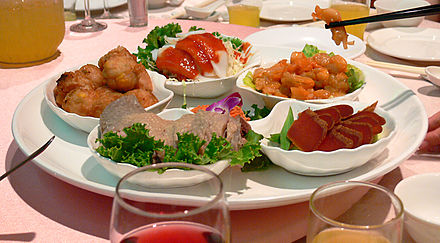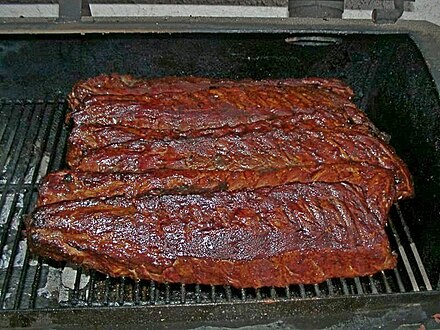Mongolian barbecue

Mongolian barbecue (Chinese: 蒙古烤肉; pinyin: Měnggǔ kǎoròu; Wade–Giles: Mêng²-ku³ K'ao³-jou⁴) is a stir-fried dish that was developed in Taiwan during the 1950s.[1][2] Despite its name, the dish is not Mongolian and is only loosely related to barbecue.[3][4]
Origin

Mongolian barbecue was created by Taiwanese comedian and restaurateur Wu Zhaonan. A native of Beijing, Wu fled to Taiwan after the outbreak of the Chinese Civil War, and opened a street food stall in Yingqiao, Taipei in 1951.[1][2] While he initially wished to name the dish "Beijing barbecue", due to political sensitivity associated with the city which had been recently designated as the capital of the People's Republic of China, the name "Mongolian barbecue" was chosen despite the lack of connection to Mongolia.[5]
Wu's food stall attracted a wide clientele including diplomats and wealthy businesspeople despite serving a relatively cheap and unsophisticated dish;[citation needed] however, it was later destroyed by flooding originating from a typhoon during which Wu almost drowned.[5] He was later able to develop a highly successful career as a comedian and left the restaurant business. Numerous imitators emerged to capitalize on the popularity of the dish he created, including Genghis Khan, Tang Palace, Great Khan, and Heavenly Khan.[5] The dish was later successfully introduced outside Taiwan.[3]
Preparation
This section needs additional citations for verification. (March 2023) |

Typically, diners select a variety of raw ingredients from a display of sliced meat (such as beef, pork, lamb, turkey, chicken, and shrimp) and vegetables (such as cabbage, tofu, onion, broccoli, and mushrooms). The bowl of ingredients is handed to the chef who then adds the diner's choice of sauce and is transferred to a grill.
The circular shape of the grill allows two or more chefs to cook food simultaneously and quickly and the food is typically prepared as the grill is revolved around. Oil or water may be added while the ingredients are stir-fried continuously over the high heat with the food items remaining intact.
Some American chains place the food on different parts of the round grill separated by a special wedge shaper. Each dish is stirred in its turn, as the operator walks around the outside of the grill and turns each individual's food in succession.
When cooking is complete, each finished dish is scooped into a bowl and handed to the diner. Many Mongolian barbecue restaurants follow an all-you-can-eat buffet format, allowing multiple visits to the grill.
See also
- Asado
- Bulgogi, a popular Korean stir-fried grill dish
- Jingisukan, a popular Japanese stir-fried grill dish
- Khorkhog, a Mongolian dish referred to as "Mongolian barbecue"
- Korean BBQ refers to a variety of grilled dishes in Korean cuisine
- List of Taiwanese inventions and discoveries
- Saj, a convex griddle used in central, south, and west Asia, eastern and Southern Europe and the Caribbean for cooking bread and meat
- Taiwanese cuisine
- Teppanyaki, a similar Japanese style of cooking
Notes
- ^ a b Chang, Eddy (2018-11-01). "Ceremony to be held honoring late crosstalk master Wu Zhao-nan". Taipei Times. Retrieved 6 November 2018.
- ^ a b Chang, Eddy (24 July 2014). "Restaurant review: Genghis Khan Mongolian Bar-B-Q". Taipei Times. Retrieved 6 November 2018.
- ^ a b Calta, Marialisa (December 14, 1988). "AT THE NATION'S TABLE; Appleton, Wis". The New York Times. Retrieved 2018-11-06.
- ^ Schwabe, Calvin W. (1979). Unmentionable Cuisine. University of Virginia Press. p. 125. ISBN 978-0-8139-1162-5.
- ^ a b c Liang Fengrong 梁峰榮 (13 December 2012). "呷台灣/吳兆南發明的蒙古烤肉 蒙古吃不到". Xin News. Archived from the original on 2018-11-07. Retrieved 2018-11-06.

